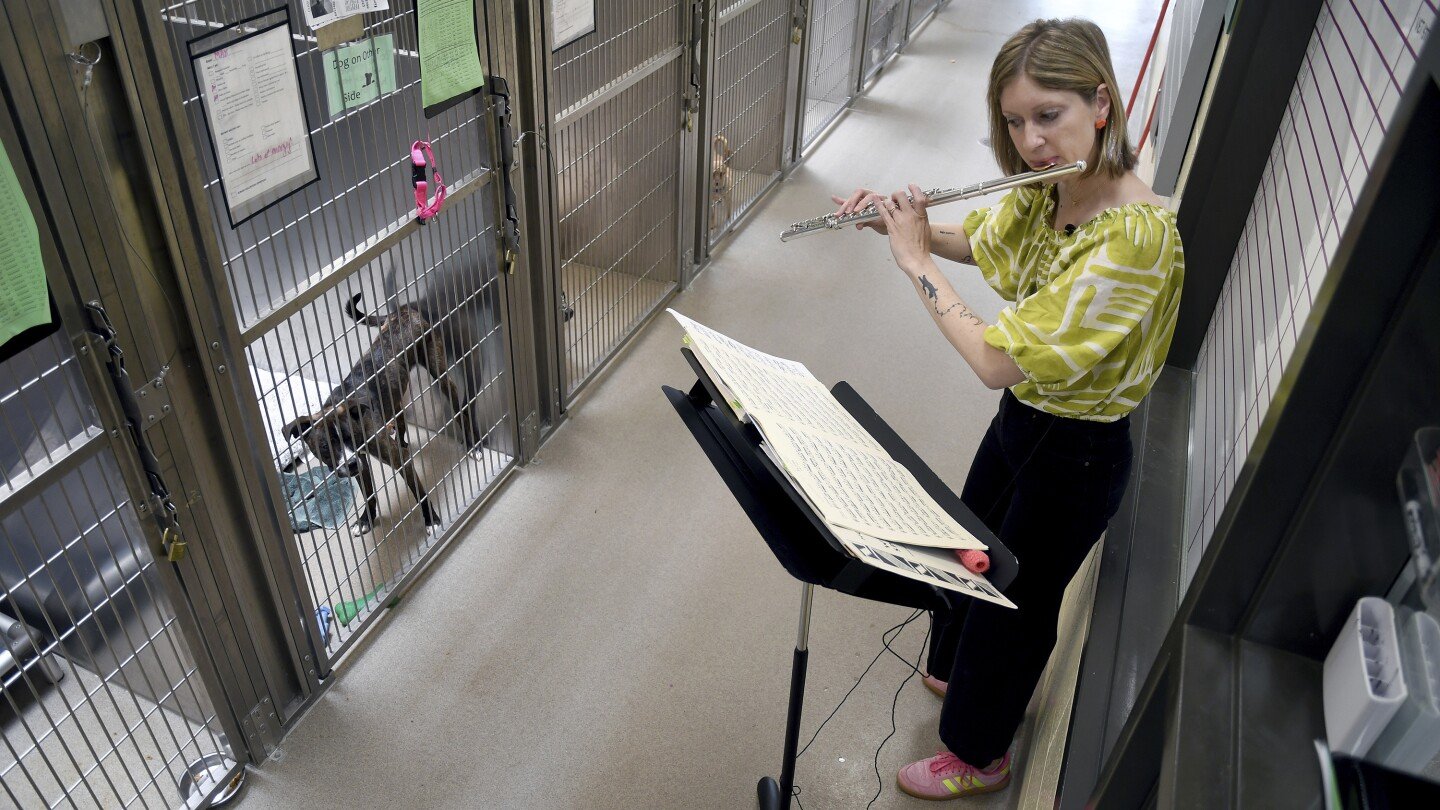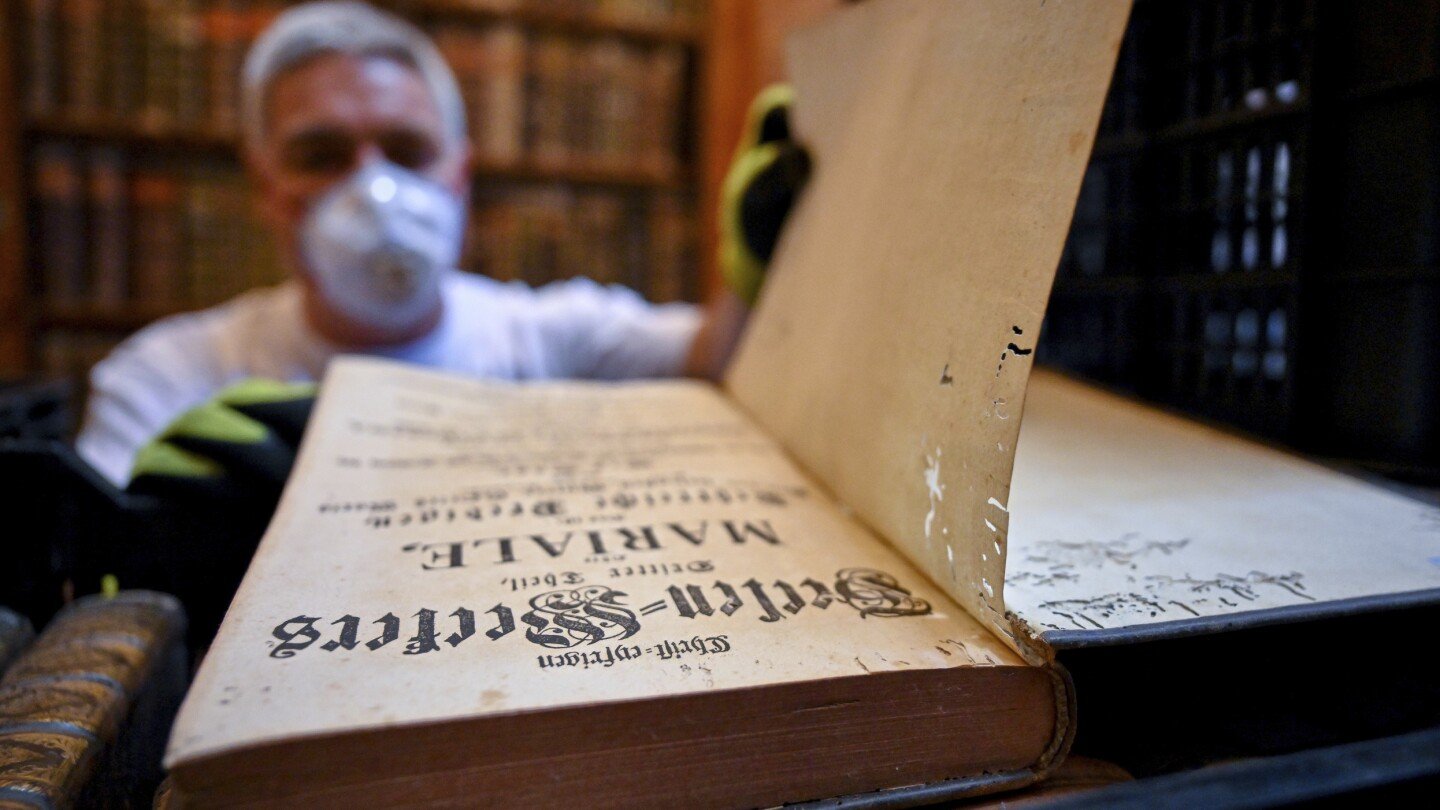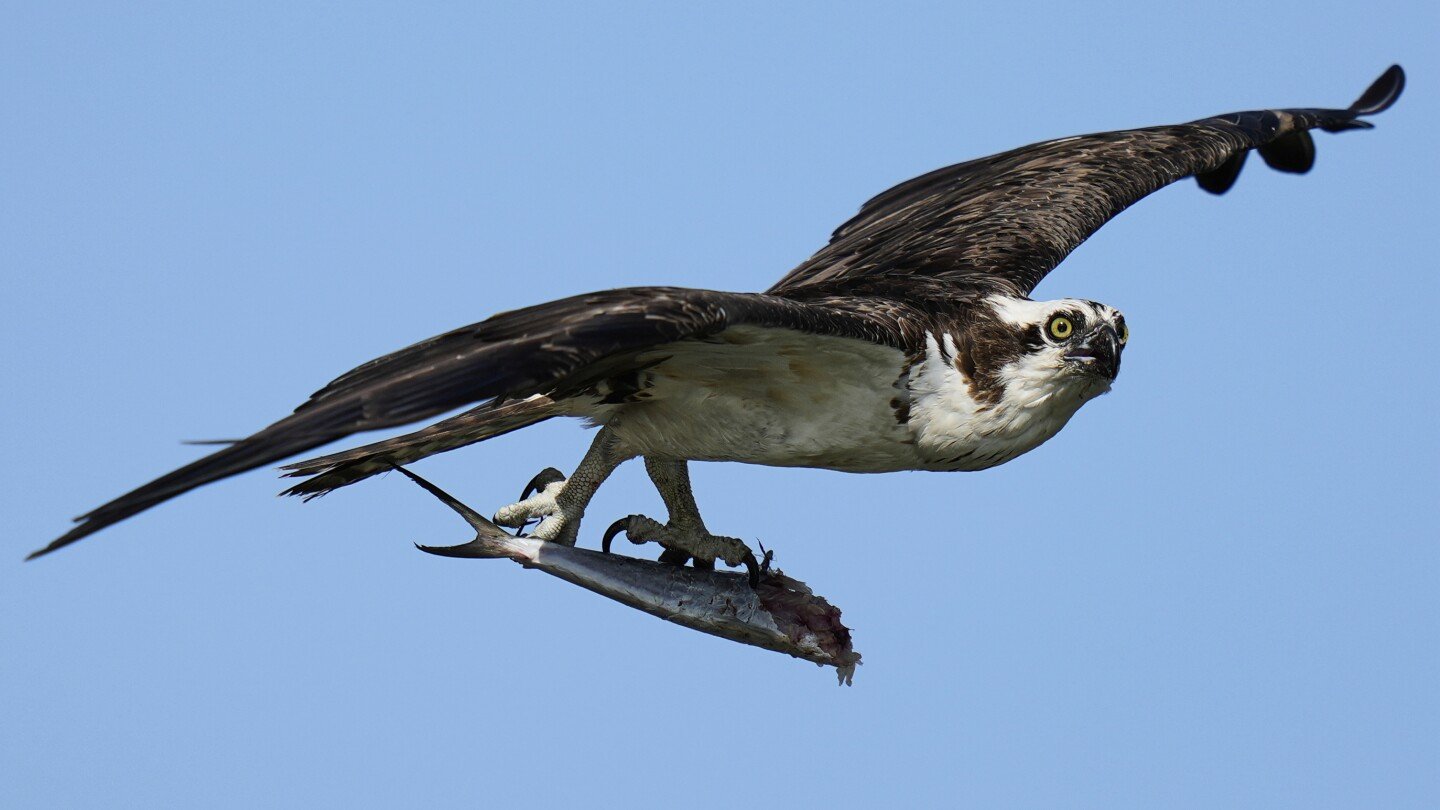Lifestyle
Volunteers use the universal language of music to soothe shelter animals

DENVER (AP) — It’s often said music is the universal language of humanity. Now a 12-year-old Houston boy is putting that to the test among an unlikely audience — man’s best friend.
Yuvi Agarwal started playing keyboard when he was 4 and several years ago noticed his playing soothed his family’s restless golden doodle, Bozo. He grew curious if it also could help stressed homeless animals.
With help from his parents, who both have backgrounds in marketing, he founded the nonprofit Wild Tunes in 2023 to recruit musicians to play in animal shelters. So far he has enlisted about 100 volunteer musicians and singers of all ages and abilities to perform at nine shelters in Houston, New Jersey and Denver.
“You don’t have to understand the lyrics to enjoy the music. Just enjoy the melody, the harmony and the rhythms. So it transcends linguistic barriers, and even it can just transcend species,” Agarwal said recently after playing hits like The Beatles’ “Hey Jude” and Ed Sheeran’s “Perfect” on his portable keyboard at the Denver Animal Shelter.
Agarwal, who was playing for an elderly miniature poodle named Pituca — Spanish slang sometimes used to describe a snob — said many of his four-legged listeners, which include cats, become excited when he enters their kennel. But after a few minutes of playing, they calm down. Some even go to sleep.
He remembers a rescue dog named Penelope that refused to come out of her enclosure in Houston to be fed.
“Within a short period of me playing, she went from not even coming out of her kennel to licking me all over my face and nibbling my ears,” Agarwal said.
A few stalls down from where he was jamming on his keyboard at the Denver shelter, volunteer Sarah McDonner played Mozart and Bach on her flute for Max, a 1-year-old stray boxer that tilted his head when she hit the high notes.
“The animals having that human interaction in a positive way, I think, gives them something to look forward to, something that is different throughout their day,” said McDonner, a professional musician who met Argawal in Houston.
She helped bring the program to Colorado after moving to Denver a few months ago. “I think it’s very important to give them something different from what they’re used to in their little tiny cages … and makes them more adoptable in the long run,” McDonner said.
While the effect of music on humans has been studied extensively, its role in animal behavior remains murky.
Several studies suggest that classical music generally has a calming influence on dogs in stressful environments like kennels, shelters and veterinary clinics. But some researchers warn there is not enough data to support the claim.
“We always want these really simplistic answers. So we want to say that music calms animals, for example, and I think that it’s much more nuanced than that,” said Lori Kogan, a self-described “dog-person” who chairs the human-animal interaction section of the American Psychological Association. “There’s a lot more research that needs to happen before I think that we can unequivocally say that music is a great thing for animals.”
Kogan, a professor and researcher at Colorado State University, has studied for more than two decades how animals and humans get along. Research involving the effect of music on dogs often produces mixed results, she said, because there are so many variables: the setting; the volume, type and tempo of the music and the breed of the dog and its previous exposure to music.
She suggests a case-by-case approach to introducing music to animals.
“If you play music for your pet, and they seem to like it and they appear calmer, then I think we can say that that’s a positive thing, that you’re providing some level of enrichment for that pet. … I would encourage people to give it a try and to see how their pets respond,” she said.
For Agarwal, his firsthand experience at shelters is undeniable evidence that music helps comfort stressed animals, and he plans to grow Wild Tunes into a nationwide program. The volunteers get something out of it, too, he said.
“You get a really great way to practice your instrument or sing in front of a nonjudgmental audience, which can boost your confidence,” he said.
Lifestyle
Hungary’s oldest library is fighting to save 100,000 books from a beetle infestation

PANNONHALMA, Hungary (AP) — Tens of thousands of centuries-old books are being pulled from the shelves of a medieval abbey in Hungary in an effort to save them from a beetle infestation that could wipe out centuries of history.
The 1,000-year-old Pannonhalma Archabbey is a sprawling Benedictine monastery that is one of Hungary’s oldest centers of learning and a UNESCO World Heritage site.
Restoration workers are removing about 100,000 handbound books from their shelves and carefully placing them in crates, the start of a disinfection process that aims to kill the tiny beetles burrowed into them.
The drugstore beetle, also known as the bread beetle, is often found among dried foodstuffs like grains, flour and spices. But they also are attracted to the gelatin and starch-based adhesives found in books.
They have been found in a section of the library housing around a quarter of the abbey’s 400,000 volumes.
“This is an advanced insect infestation which has been detected in several parts of the library, so the entire collection is classified as infected and must be treated all at the same time,” said Zsófia Edit Hajdu, the chief restorer on the project. “We’ve never encountered such a degree of infection before.”
Abbey houses historical treasures
The beetle invasion was first detected during a routine library cleaning. Employees noticed unusual layers of dust on the shelves and then saw that holes had been burrowed into some of the book spines. Upon opening the volumes, burrow holes could be seen in the paper where the beetles chewed through.
The abbey at Pannonhalma was founded in 996, four years before the establishment of the Hungarian Kingdom. Sitting upon a tall hill in northwestern Hungary, the abbey houses the country’s oldest collection of books, as well as many of its earliest and most important written records.
For over 1,000 years, the abbey has been among the most prominent religious and cultural sites in Hungary and all of Central Europe, surviving centuries of wars and foreign incursions such as the Ottoman invasion and occupation of Hungary in the 16th century.
Ilona Ásványi, director of the Pannonhalma Archabbey library, said she is “humbled” by the historical and cultural treasures the collection holds whenever she enters.
“It is dizzying to think that there was a library here a thousand years ago, and that we are the keepers of the first book catalogue in Hungary,” she said.
Among the library’s most outstanding works are 19 codices, including a complete Bible from the 13th century. It also houses several hundred manuscripts predating the invention of the printing press in the mid-15th century and tens of thousands of books from the 16th century.
While the oldest and rarest prints and books are stored separately and have not been infected, Ásványi said any damage to the collection represents a blow to cultural, historical and religious heritage.
“When I see a book chewed up by a beetle or infected in any other way, I feel that no matter how many copies are published and how replaceable the book is, a piece of culture has been lost,” she said.
Books will spend weeks in an oxygen-free environment
To kill the beetles, the crates of books are being placed into tall, hermetically sealed plastic sacks from which all oxygen is removed. After six weeks in the pure nitrogen environment, the abbey hopes all the beetles will be destroyed.
Before being reshelved, each book will be individually inspected and vacuumed. Any book damaged by the pests will be set aside for later restoration work.
Climate change may have contributed
The abbey, which hopes to reopen the library at the beginning of next year, believes the effects of climate change played a role in spurring the beetle infestation as average temperatures rise rapidly in Hungary.
Hajdu, the chief restorer, said higher temperatures have allowed the beetles to undergo several more development cycles annually than they could in cooler weather.
“Higher temperatures are favorable for the life of insects,” she said. “So far we’ve mostly dealt with mold damage in both depositories and in open collections. But now I think more and more insect infestations will appear due to global warming.”
The library’s director said life in a Benedictine abbey is governed by a set of rules in use for nearly 15 centuries, a code that obliges them to do everything possible to save its vast collection.
“It says in the Rule of Saint Benedict that all the property of the monastery should be considered as of the same value as the sacred vessel of the altar,” Ásványi said. “I feel the responsibility of what this preservation and conservation really means.”
Lifestyle
Osprey are declining and environmentalists blame fishing industry’s take of menhaden

GLOUCESTER POINT, Va. (AP) — Stepping onto an old wooden duck blind in the middle of the York River, Bryan Watts looks down at a circle of sticks and pine cones on the weathered, guano-spattered platform. It’s a failed osprey nest, taken over by diving terns.
“The birds never laid here this year,” said Watts, near the mouth of Virginia’s Chesapeake Bay. “And that’s a pattern we’ve been seeing these last couple of years.”
An osprey is silhouetted as it perches atop a nest on the Lynnhaven River, June 30, 2025, in Virgina Beach, Va. (AP Photo/Stephanie Scarbrough)
Watts has a more intimate relationship with ospreys than most people have with a bird — he has climbed to their nests to free them from plastic bags, fed them by hand and monitored their eggs with telescopic mirrors.
The fish-eating raptor known for gymnastic dives and whistle-like chirps is an American conservation success story. After pesticides and other hazards nearly eliminated the species from much of the country, the hawk-like bird rebounded after the banning of DDT in 1972 and now numbers in the thousands in the U.S.
An osprey flies with a half-eaten fish in its talons above the Lynnhaven River, June 30, 2025, in Virginia Beach, Va. (AP Photo/Stephanie Scarbrough)
But Watts has documented an alarming trend. The birds, which breed in many parts of the U.S., are failing to successfully fledge enough chicks around their key population center of the Chesapeake Bay. The longtime biologist blames the decline of menhaden, a small schooling fish critical to the osprey diet. Without menhaden to eat, chicks are starving and dying in nests, Watts said.
Osprey are an environmental indicator
Watts’s claim has put him and environmental groups at odds with the fishing industry, trade unions and sometimes government regulators. Menhaden is valuable for fish oil, fish meal and agricultural food as well as bait.
U.S. fishermen have caught at least 1.1 billion pounds of menhaden every year since 1951. Members of the industry tout its sustainability and said the decline in osprey may have nothing to do with fishing.
But without help, the osprey population could tumble to levels not seen since the dark days of DDT, said Watts, director of the Center for Conservation Biology at The College of William & Mary in Williamsburg, Virginia.
Brian Watts, research professor and director of the Center for Conservation Biology at The College of William & Mary, looks over at failed osprey nest atop a wooden duck blind on the Lower York River, June 30, 2025, in Gloucester Point, Va. (AP Photo/Stephanie Scarbrough)
“The osprey are yelling pretty loudly that, hey, there’s not enough menhaden for us to reproduce successfully,” Watts said. “And we should be listening to them to be more informed fully on the fisheries side, and we should take precaution on the fisheries management side. But that hasn’t won the day at this point.”
Decline linked to menhaden in studies
Watts, who has studied osprey on the Chesapeake for decades, has backed his claims of population decline by publishing studies in scientific journals. He said it boils down to a simple statistic — to maintain population, osprey pairs need to average 1.15 chicks per year.
Osprey were reproducing at that level in the 1980s, but today in some areas around the main stem of the Chesapeake, it’s less than half of that, Watts said. In particularly distressed areas, they aren’t even reproducing at one-tenth that level, he said. And the decline in available menhaden matches the areas of nesting failure, Watts said.
A bald eagle, left, steals a fish from an osprey before it could feed above the Lynnhaven River, June 30, 2025, in Virginia Beach, Va. (AP Photo/Stephanie Scarbrough)
Also called pogies or bunkers, the oily menhaden are especially important for young birds because they are more nutritious than other fish in the sea. Osprey “reproductive performance is inextricably linked to the availability and abundance” of menhaden, Watts wrote in a 2023 study published in Frontiers in Marine Science.
Conservationists have been concerned for years, saying too many menhaden have been removed to maintain their crucial role in the ocean food chain. Historian H. Bruce Franklin went so far as to title his 2007 book on menhaden “The Most Important Fish In The Sea.”
Fishing industry pushes back
Menhaden help sustain one of the world’s largest fisheries, worth more than $200 million at the docks in 2023. Used as bait, the fish are critical for valuable commercial targets such as Maine lobster. They’re also beloved by sportfishermen.
The modern industry is dominated by Omega Protein, a Reedville, Virginia, company that is a subsidiary of Canadian aquaculture giant Cooke. The company pushed back at the idea that fishing is the cause of osprey decline, although it did acknowledge that fewer menhaden are showing up in some parts of the bay.
Federal data show osprey breeding is in decline in many parts of the country, including where menhaden is not harvested at all, said Ben Landry, an Omega spokesperson. Climate change, pollution and development could be playing a role, said Landry and others with the company.
Blaming fishing “just reeks of environmental special interest groups having an influence over the process,” Landry said.
New rules could be on the way
The menhaden fishery is managed by the Atlantic States Marine Fisheries Commission, an interstate body that crafts rules and sets fishing quotas. Prompted by questions about ospreys, it created a work group to address precautionary management of the species in the Chesapeake Bay.
A young osprey returns to its nest on the Lynnhaven River, June 30, 2025, in Virginia Beach, Va. (AP Photo/Stephanie Scarbrough)
In April, this group proposed several potential management approaches, including seasonal closures, restrictions on quotas or days at sea, and limitations on kinds of fishing gear. The process of creating new rules could begin this summer, said James Boyle, fishery management plan coordinator with the commission.
The osprey population has indeed shown declines in some areas since 2012, but it’s important to remember the bird’s population is much larger than it was before DDT was banned, Boyle said.
“There are big increases in osprey population since the DDT era,” Boyle said, citing federal data showing a six-fold increase in osprey populations along the Atlantic Coast since the 1960s.
Environmentalists says bird’s decline could worsen
To a number of environmental groups, any decline is too much. This irritates some labor leaders who worry about losing more jobs as the fishing industry declines.
Kenny Pinkard, retired vice president of UFCW Local 400’s executive board and a longtime Virginia fishermen, said he feels the industry is being scapegoated.
“There are some people who just don’t want to see us in business at all,” he said.
But Chris Moore, Virginia executive director for Chesapeake Bay Foundation, said the country risks losing an iconic bird if no action is taken. He said Watts’s studies show that the osprey will fail without access to menhaden.
“Osprey have been a success story,” Moore said. “We’re in a situation where they’re not replacing their numbers. We’ll actually be in a situation where we’re in a steep decline.”
___
Whittle reported from Portland, Maine.
___ This story was supported by funding from the Walton Family Foundation. The AP is solely responsible for all content.
Lifestyle
Cooling gadgets and wearables can help you beat the heat

You can only sit in front of the fridge with the door open for so long.
As heat waves blast the world like a blow dryer on high, folks are reaching for anything that promises a little personal chill: portable mini fans, cooling neck wraps, high-tech vests and all kinds of heat-beating headwear.
Of course, cooling gear helps most when paired with basic and safe strategies against the heat: most importantly hydration, shade and rest. Stay out of extreme heat when possible, and know the signs of heat exhaustion or heat stroke.
Yet these wearable wonders and breezy gadgets can offer some relief. They might look quirky, but when the AC struggles and the sidewalk feels like a stovetop, they can start to seem like must-haves.
When you’re at home
Indoors, stay comfy with cool-feel sheets (like those with a silky finish or lightweight fibers), bed fans (where a nozzle inserted into the bed linens pumps a flow of air around you), or a cooling pillow or chill pad, which are filled with a gel that can stay cool for hours. Sleep-product brands include Serta, Sealy, Casper, Pluto and Threshold.
The chill pads can work for your own bed and the pets’ bed too. There are chillable full-size mattresses (Chilipad, 8Sleep and BedJet get good reviews from The Spruce) and smaller, simple pads (CoolCare and Sharper Image, among others).
Outdoor wearables
Clare Epstein, an employee safety expert with Vector Solutions in Tampa, Florida, works to reduce heat stress for at-risk employees in industries like construction, aviation and agriculture. She recommends wearables like cooling scarves and evaporative cooling vests.
“By soaking the fabric in cold water at the beginning of the day, the vest slowly cools, and keeps the wearer cool,” she says.
Clothes made of “phase change materials,” or PCMs, contain gel capsules or pads that can help moderate body temperatures. Uline.com advertises a vest that stays under 60 degrees for a few hours, and AlphaCool offers a neck tube that performs similarly. Another feature of the tube, which is made of a polymer material, is that it doesn’t get overly chilled, so it’s safe for kids to use.
Also for kids, there’s a line of plush toys from Warmies that includes little critters of the farmyard, ocean, forest and safari that can be popped in the freezer before a trip to the park or playground.
Wearable items that incorporate small fans or thermoelectric coolers are also good, Epstein says. And there are vests with tubed reservoirs you can fill with water or electrolytes so you can sip as you go.
“These encourage people to take more water breaks, and stay hydrated,” says Epstein.
The wearables range is extensive. Along with cooling buffs, headbands, wristbands, socks and scarves, there are cooling brimmed hats and ball caps. Brands include Mission, Ergodyne, and Sunday Afternoon.
If you’d prefer a refreshing breeze, USB-chargeable handheld or wearable fans might do the job.
Chill advice
Lynn Campbell, co-founder of 10Adventures travel company in Calgary, Alberta, takes a lot of strenuous hiking and cycling trips with her husband, Richard. They’ve developed some easy hacks for hot days.
“We’ll wake up early, so we’re done by 10 or 11 a.m., or if we’re out on the trails, split the day in two, so we rest by water or in the shade over the hottest part” of the day, she says.
Wear light colors and thin, breathable fabrics.
And bring an umbrella. “This is a game-changer,” Campbell says. “Now we always pack ultralight, compact ones; they’re incredible.”
Also, pour cool water on your head and back. “We freeze a few bottles of water so we can pour ice water on us to cool down,” Campbell says. “Putting the bottles under the armpits, in the groin, or on the back of the neck can effectively cool a person down.”
And Annita Katee, a contributing writer for Apartment Therapy, has another way to prep your bed on hot nights:
“Pop your sheets into the freezer at least two hours before bedtime, then pull them out right before you hit the sack,” she wrote in a recent post. She folds hers into a zipped plastic bag, flattens it, then sets it on a freezer shelf between ice packs.
“The result? A delightfully cool bed that feels like a refreshing oasis against the heat.”
___
New York-based writer Kim Cook covers design and decor topics regularly for The AP. Follow her on Instagram at @kimcookhome.
For more AP Lifestyles stories, go to https://apnews.com/lifestyle
-

 Asia4 days ago
Asia4 days agoA torpedoed US Navy ship escaped the Pacific in reverse, using coconut logs. Its sunken bow has just been found
-

 Asia4 days ago
Asia4 days agoGujarat state: Bridge collapse kills 9 in India
-

 Europe4 days ago
Europe4 days agoTrump promised 200 deals by now. He’s gotten 3, and 1 more is getting very close
-

 Lifestyle5 days ago
Lifestyle5 days agoFaith-based camps like those hit by Texas floods are rite of passage for many
-

 Africa5 days ago
Africa5 days ago30% on South African imports: Ramaphosa hits back at new Trump tariffs
-

 Europe4 days ago
Europe4 days agoExtreme heat is a killer. A recent heat wave shows how much more deadly its becoming as humans warm the world
-

 Lifestyle5 days ago
Lifestyle5 days agoArmani couture channels black as maestro misses Paris bow for 1st time, days from 91st birthday
-

 Africa5 days ago
Africa5 days agoUN Human Rights Office says ‘deeply troubled’ by Kenya protester deaths




